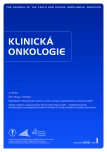Venous Access Devices in Oncology
Authors:
V. Maňásek; R. Soumarová; I. Kociánová; M. Maňásková
Authors place of work:
Komplexní onkologické centrum, Nový Jičín
Published in the journal:
Klin Onkol 2012; 25(1): 9-16
Category:
Přehledy
Summary
Specific anti-cancer therapy is administered mainly via the parenteral route, Adequate venous access is, therefore, a topical issue in oncology In some patients on long-term therapy, the peripheral venous system is extensively burdened We present an overview of risk factors associated with parenteral application of medicins We provide a comparison of different types of venous access devices and discuss recommendations on general indications for permanent venous access devices We suggest an approach to the choice of the most appropriate venous access device for an oncology patient available to date We present our experience with PICC (peripherally implanted central catheters) implantations used in 30 oncology patients in our centre In addition to venous ports, PICCs represent another safe method of permanent venous access with low rate of complications Indications for the use of a specific permanent venous access device (PICC or port) partly overlap and evidenced-based recommendations are lacking However, we discuss the few suggestions that have been formulated on this issue
Key words:
venous catheterization – vascular access ports – chemotherapy – cancer
The authors declare they have no potential conflicts of interest concerning drugs, products, or services used in the study.
The Editorial Board declares that the manuscript met the ICMJE “uniform requirements” for biomedical papers.
Submitted:
1. 5. 2011
Accepted:
15. 9. 2011
Zdroje
1. Tilton H. How to fine-tune your PICC care. RN 2006; 69(9): 30–5; quiz 36, 44.
2. Gallieni M, Pittiruti M, Biffi R. Vascular access in oncology patients. CA Cancer J Clin 2008; 58(6): 323–346.
3. Fry C, Aholt D. Local anesthesia prior to the insertion of peripherally inserted central catheters. J Infus Nurs 2001; 24(6): 404–408.
4. Forauer AR, Alonzo M. Change in peripherally inserted central catheter tip position with abduction and adduction of the upper extremity. J Vasc Interv Radiol 2000; 11(10): 1315–1318.
5. Tamburro RF, Conner DT, Proctor KE et al. The effect of a mediastinal mass on the initial positioning of a peripherally inserted central venous catheter. J Infus Nurs 2003; 26(2): 92–96.
6. Harter C, Ostendorf T, Bach A et al. Peripherally inserted central venous catheters for autologous blood progenitor cell transplantation in patients with haematological malignancies. Support Care Cancer 2003; 11(12): 790–794.
7. Griffiths VR, Philpot P. Peripherally inserted central catheters (PICCs): do they have a role in the care of the critically ill patient? Intensive Crit Care Nurs 2002; 18(1): 37–47.
8. Simcock L. No going back: advantages of ultrasound-guided upper arm PICC placement. JAVA 2008; 13(4): 191–197.
9. Hoffer EK, Borsa J, Santulli P et al. Prospective randomized comparison of valved versus nonvalved peripherally inserted central vein catheters. AJR Am J Roentgenol 1999; 173(5): 1393–1398.
10. Hoffer EK, Bloch RD, Borsa JJ et al. Peripherally inserted central catheters with distal versus proximal valves: prospective randomized trial. J Vasc Interv Radiol 2001; 12(10): 1173–1177.
11. Periard D, Monney P, Waeber G et al. Randomized controlled trial of peripherally inserted central catheters vs. peripheral catheters for middle duration in-hospital intravenous therapy. J Thromb Haemost 2008; 6(8): 1281–1288.
12. Cheong K, Perry D, Karapetis C et al. High rate of complications associated with peripherally inserted central venous catheters in patients with solid tumours. Intern Med J 2004; 34(5): 234–238.
13. Walshe LJ, Malak SF, Eagan J et al. Complication rates among cancer patients with peripherally inserted central catheters. J Clin Oncol 2002; 20(15): 3276–3281.
14. Yap YS, Karapetis C, Lerose S et al. Reducing the risk of peripherally inserted central catheter line complications in the oncology setting. Eur J Cancer Care (Engl) 2006; 15(4): 342–347.
15. Grove JR, Pevec WC. Venous thrombosis related to peripherally inserted central catheters. J Vasc Interv Radiol 2000; 11(7): 837–840.
16. Cortelezzi A, Fracchiolla NS, Maisonneuve P et al. Central venous catheter-related complications in patients with hematological malignancies: a retrospective analysis of risk factors and prophylactic measures. Leuk Lymphoma 2003; 44(9): 1495–1501.
17. Yi S, Wang Y, Li D et al. Influence of PICC catheter pretreatment on the mechanical phlebitis in breast cancer patients receiving chemotherapy. Chinese J Clin Oncol Rehab 2007; 1.
18. Hachem R, Raad I. Prevention and management of long-term catheter related infections in cancer patients. Cancer Invest 2002; 20(7–8): 1105–1113.
19. Hanna H, Benjamin R, Chatzinikolaou I et al. Long-term silicone central venous catheters impregnated with minocycline and rifampin decrease rates of catheter-related bloodstream infection in cancer patients: a prospective randomized clinical trial. J Clin Oncol 2004; 22(15): 3163–3171.
20. Miller DL, O’Grady NP. Guidelines for the prevention of intravascular catheter-related infections: recommendations relevant to interventional radiology. J Vasc Interv Radiol 2003; 14 (9 Pt 2): S355–S358.
21. Gebauer B. Uncommon approaches in venous access. Macova 4th Multidisciplinary advanced course on venous access. London, 20th–22nd October 2010 [online]. Available from www.evanetwork.info/uploads/macova_iv-draft_agenda.pdf.
22. Cardiaccarestaffing.com [online]. 2008. Cardiac care staffing. Available from http://cardiaccarestaffing.com/piccline.html.
Štítky
Dětská onkologie Chirurgie všeobecná OnkologieČlánek vyšel v časopise
Klinická onkologie

2012 Číslo 1
- Metamizol jako analgetikum první volby: kdy, pro koho, jak a proč?
- Management pacientů s MPN a neobvyklou kombinací genových přestaveb – systematický přehled a kazuistiky
- Management péče o pacientku s karcinomem ovaria a neočekávanou mutací CDH1 – kazuistika
- Neodolpasse je bezpečný přípravek v krátkodobé léčbě bolesti
- Cinitaprid – v Česku nová účinná látka nejen pro léčbu dysmotilitní dyspepsie
Nejčtenější v tomto čísle
- Žilní vstupy v onkologii
- Využitie elektroimpedančnej tomografie v diagnostike karcinómu prsníka
- Identifikácia molekulárnych markerov u detí s akútnou myeloblastovou leukémiou (AML)
- Šestileté sledování pacienta s mnohočetnou angiomatózou postihující skelet, břišní i hrudní dutinu a stěnu trávicí trubice
